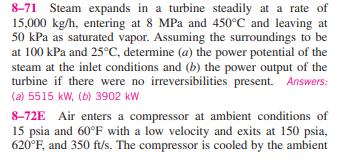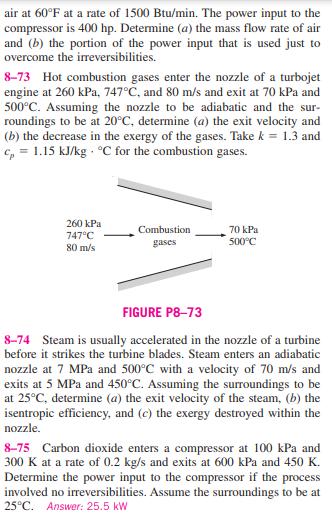Answered step by step
Verified Expert Solution
Question
1 Approved Answer
8-71 Steam expands in a turbine steadily at a rate of 15,000 kg/h, entering at 8 MPa and 450C and leaving at 50 kPa


8-71 Steam expands in a turbine steadily at a rate of 15,000 kg/h, entering at 8 MPa and 450C and leaving at 50 kPa as saturated vapor. Assuming the surroundings to be at 100 kPa and 25C, determine (a) the power potential of the steam at the inlet conditions and (b) the power output of the turbine if there were no irreversibilities present. Answers: (a) 5515 kW, (b) 3902 kW 8-72E Air enters a compressor at ambient conditions of 15 psia and 60F with a low velocity and exits at 150 psia, 620F, and 350 ft/s. The compressor is cooled by the ambient air at 60F at a rate of 1500 Btu/min. The power input to the compressor is 400 hp. Determine (a) the mass flow rate of air and (b) the portion of the power input that is used just to overcome the irreversibilities. 8-73 Hot combustion gases enter the nozzle of a turbojet engine at 260 kPa, 747C, and 80 m/s and exit at 70 kPa and 500C. Assuming the nozzle to be adiabatic and the sur- roundings to be at 20C, determine (a) the exit velocity and (b) the decrease in the exergy of the gases. Take k = 1.3 and c = 1.15 kJ/kg. C for the combustion gases. 260 kPa 747C Combustion gases 70 kPa 500C 80 m/s FIGURE P8-73 8-74 Steam is usually accelerated in the nozzle of a turbine before it strikes the turbine blades. Steam enters an adiabatic nozzle at 7 MPa and 500C with a velocity of 70 m/s and exits at 5 MPa and 450C. Assuming the surroundings to be at 25C, determine (a) the exit velocity of the steam, (b) the isentropic efficiency, and (c) the exergy destroyed within the nozzle. 8-75 Carbon dioxide enters a compressor at 100 kPa and 300 K at a rate of 0.2 kg/s and exits at 600 kPa and 450 K. Determine the power input to the compressor if the process involved no irreversibilities. Assume the surroundings to be at 25C. Answer: 25.5 kW 8-71 Steam expands in a turbine steadily at a rate of 15,000 kg/h, entering at 8 MPa and 450C and leaving at 50 kPa as saturated vapor. Assuming the surroundings to be at 100 kPa and 25C, determine (a) the power potential of the steam at the inlet conditions and (b) the power output of the turbine if there were no irreversibilities present. Answers: (a) 5515 kW, (b) 3902 kW 8-72E Air enters a compressor at ambient conditions of 15 psia and 60F with a low velocity and exits at 150 psia, 620F, and 350 ft/s. The compressor is cooled by the ambient air at 60F at a rate of 1500 Btu/min. The power input to the compressor is 400 hp. Determine (a) the mass flow rate of air and (b) the portion of the power input that is used just to overcome the irreversibilities. 8-73 Hot combustion gases enter the nozzle of a turbojet engine at 260 kPa, 747C, and 80 m/s and exit at 70 kPa and 500C. Assuming the nozzle to be adiabatic and the sur- roundings to be at 20C, determine (a) the exit velocity and (b) the decrease in the exergy of the gases. Take k = 1.3 and c = 1.15 kJ/kg. C for the combustion gases. 260 kPa 747C Combustion gases 70 kPa 500C 80 m/s FIGURE P8-73 8-74 Steam is usually accelerated in the nozzle of a turbine before it strikes the turbine blades. Steam enters an adiabatic nozzle at 7 MPa and 500C with a velocity of 70 m/s and exits at 5 MPa and 450C. Assuming the surroundings to be at 25C, determine (a) the exit velocity of the steam, (b) the isentropic efficiency, and (c) the exergy destroyed within the nozzle. 8-75 Carbon dioxide enters a compressor at 100 kPa and 300 K at a rate of 0.2 kg/s and exits at 600 kPa and 450 K. Determine the power input to the compressor if the process involved no irreversibilities. Assume the surroundings to be at 25C. Answer: 25.5 kW
Step by Step Solution
There are 3 Steps involved in it
Step: 1

Get Instant Access to Expert-Tailored Solutions
See step-by-step solutions with expert insights and AI powered tools for academic success
Step: 2

Step: 3

Ace Your Homework with AI
Get the answers you need in no time with our AI-driven, step-by-step assistance
Get Started


